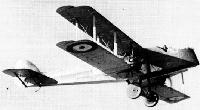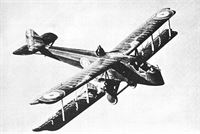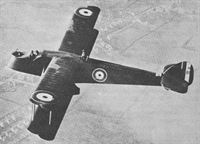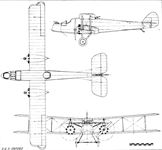A.Jackson De Havilland Aircraft since 1909 (Putnam)
De Havilland D.H.11 Oxford
Although the D.H.11 long distance day bomber was intended as a D.H.10 replacement and retained the twin engined, three bay layout of the earlier type, it would be difficult to visualise two more dissimilar aeroplanes. They were structurally identical having fabric covered, wooden airframes incorporating steel tubing for highly stressed or vulnerable members such as engine mountings, undercarriage and the empennage trailing edges. Both types also had horn balanced ailerons and the characteristic de Havilland rudder, but there the similarity ended. Four degrees of dihedral on the upper mainplane compared with two degrees on the lower, gave the wings of the D.H.11 a diverging appearance and the fuselage filled the whole mainplane gap, making it possible to put the rear gunner on a raised floor in the mid upper position with a commanding field of fire in all upward directions.
A fuselage 6 ft. 0 in. deep and 4 ft. 0 in. wide enabled main fuel tanks of 170 gallons capacity to be slung from the top longerons of the centre fuselage with a walk way beneath. This gave the rear gunner access to the cockpit, in which the pilot sat on the starboard side, and thence to the front gunner. Entry to the aircraft was gained through a trap door between the spars of the lower wing which opened on to this catwalk. Armament consisted of a Scarff-ring-mounted Lewis gun fore and aft and approximately 1,000 lb. of bombs carried internally. Two 320 h.p. A.B.C. Dragonfly radial engines were housed in nacelles fixed directly to the lower mainplane but the eminently business-like and efficient divided undercarriage of the D.H.10 gave place to a narrow track, cross-axle unit resembling that of a scaled up D.H.9A.
Designs began early in 1918 when a Contract was placed for three aircraft and by August the fuselage of the prototype, H5891, was well advanced in the Hendon factory. In September all work ceased because the Dragonfly engines were beset by problems and in November Siddeley Puma in-line, high compression engines were considered and the necessary engine bearer modifications were put in hand.
By March 1919 the machine was ready and the mainplanes were being covered yet despite recurring magneto trouble it was decided to fit the Dragonflies after all. After the first few flights H5891 went back into the works for the engines to be repositioned but was short lived. Its last flight came when a connecting rod broke in one of the engines, which seized up just as the aircraft became airborne, but the pilot, F. T. Courtney, made a masterly forced landing without damage.
SPECIFICATION AND DATA
Manufacturers: The Aircraft Manufacturing Co. Ltd. Hendon, London, N.W.9.
Power Plants:
(Mk. I) Two 320 h.p. A.B.C. Dragonfly
(Mk. II) Two 290 h.p. Siddeley Puma h.c.
Dimensions:
Span 60 ft. 2 in.
Length 45 ft. 2 3/4 in.
Height 13 ft. 6 in.
Wing area 719 sq. ft.
Weights:
Tare weight 3,795 lb.
All-up weight 7,027 lb
Estimated Performance:
Maximum speed at 6,500 ft. 117 m.p.h.
Climb to 10,000 ft. 13 1/2 min. Endurance 3J hours
Production: Prototype only, H5891, to Contract 35a/2150/C.2485. Projected Mk. IIs, H5892 and H5893, with Puma high compression engines, were not built. Serials later allotted to Sopwith Buffaloes.
Показать полностью
F.Manson British Bomber Since 1914 (Putnam)
Airco D.H.11 Oxford
It was perhaps to be expected that the manufacturers of the D.H.10 Amiens bomber should be invited to tender a design for an aircraft intended to replace that aircraft in service, and a Contract was signed with the Aircraft Manufacturing Company at Hendon for three prototypes (H5891-H5893) on 27 July 1918; all were required to be powered the 320hp ABC Dragonfly.
Like the Avro Manchester, the D.H.11 was a twin-tractor biplane with a crew of three, and was designed to carry its bomb load internally. It was, however, an entirely different design from its antecedent, the D.H.10, often being likened to an enlarged, twin-engine version of the D.H.9. Construction was entirely of wood with wings and rear fuselage fabric-covered, the fuselage nose being ply-clad. The unswept, unstaggered, parallel-chord wings were fitted with horn-balanced ailerons on upper and lower surfaces; the lower wing possessed dihedral of two degrees outboard of the engines, and the upper of four degrees from the roots, giving the illusion from some aspects that the top wing was swept forward. The engine nacelles were mounted directly on the upper surface of the lower wings.
The very deep fuselage occupied the entire wing gap, enabling the midships gunner to command an excellent all-round field of fire, while the pilot (occupying the left hand side of a very wide cockpit) and the nose gunner both enjoyed good fields of view.
It seems likely that difficulty arose with regard to locating the bomb bay, owing to the type and disposition of the undercarriage fitted on the first prototype, as well as to the position of the aircraft’s centre of gravity, a problem compounded by the fact that, when delivered, the engines were each found to be some 120 lb heavier than previously notified - a discrepancy that required hurried recalculation of weight distribution. The undercarriage was of plain V-strut design with wheel cross-axle, the upper ends of the struts being anchored to the fuselage at the junctions of the wing spars with the lower longerons. If, as seems likely, the bomb bay was to be located between the planes of the wing spars, so as to be close to the aircraft’s centre of gravity, the bombs would have fouled the wheel cross-axle. This all suggests that the first prototype was not equipped with a bomb bay and that the undercarriage was no more than a jury structure, fitted temporarily pending design of a more robust split-axle type.
Being roughly a month behind the completion of the Avro Manchester, the first D.H.11 prototype, H5891, was able to make its maiden flight in January 1919 powered by the Dragonfly engines. From the outset the aircraft encountered handling problems associated primarily with longitudinal and directional control and stability, the aircraft being nose-heavy in most flight regimes. It was therefore returned to the factory in July for repositioning of the engines - and possibly the fitting of a divided-axle undercarriage. It is not clear from records that have been located whether the D.H.11 had visited Martlesham Heath for trials in the meantime.
In any case, owing to general dissatisfaction with the Dragonfly engine, the second and third prototypes had been cancelled on 30 June by the Air Ministry. The name Oxford had been officially bestowed on the D.H.11 during 1918 and, although this appears in Air Ministry documents of that time, it seems that the name was seldom used, particularly by the manufacturers, whose reports reflect an air of frustration with the design, not least when it also emerged that the engines were not only heavier than expected, but incapable of producing the power promised.
Paradoxically, it is known that de Havilland undertook an alternative design of the D.H.11 to be powered by two 300hp high-compression Siddeley Puma engines in an Oxford Mk II, and these may have been intended for fitting in one of the uncompleted prototypes. In any case, this would have been abandoned when the Air Ministry dropped its plans to replace the D.H.10 Amiens.
Type: Twin-engine, three-seat, three-bay biplane medium bomber.
Air Ministry Specification: RAF Type IV, VI and VIII.
Manufacturer: The Aircraft Manufacturing Co Ltd, Hendon, London N.W.9
Powerplant: Two 320hp ABC Dragonfly I 9-cylinder air-cooled radial engines driving 2-blade tractor propellers.
Structure: All-wood airframe structure, ply- and fabric-covered.
Dimensions: Span, 60ft 2in; length, 45ft 2 3/4 in; height, 13ft 6in; wing area, 719 sq ft.
Weights: Tare, 4,105 lb; all-up (four 230 lb bombs), 7,027 lb.
Performance (with two 230 lb bombs): Max speed, 123 mph at sea level, 116 mph at 10,000ft; climb to 10,000ft, 13 min 45 sec; service ceiling, 14,500ft; endurance, 3 hr.
Armament: Bomb load of up to four 230 lb bombs carried internally. Gun armament comprised nose and midships 0.303in Lewis machine guns on Scarff rings.
Prototypes: One, H5891, first flown in January 1920; two others, H5892 and H5893, cancelled in 1919. No production.
Показать полностью
P.Lewis British Bomber since 1914 (Putnam)
When the Armistice came in November, 1918, the Aircraft Manufacturing Company at Hendon was part of the way through the construction of the D.H.11 Oxford prototype H5891, a three-seat, long-distance day bomber designed by Geoffrey de Havilland in 1918 around a pair of 320 h.p. A.B.C. Dragonfly engines. The arrival of peace inevitably brought a slowing-up in completion of H5891 so that its first flight did not take place until January, 1920.
The Oxford was a significant step forward in bomber design, being notably cleaner aerodynamically than its contemporaries. Centre-section struts were eliminated in the three-bay biplane wing cellules by deepening the shapely fuselage so that it filled the gap between upper and lower planes; this feature automatically made it possible to give the mid-upper gunner adjacent to the trailing edge a 360° field of fire in the upper hemisphere and enabled him to reach both the pilot’s and front gunner’s cockpits via a catwalk between all three positions. Another unusual feature in a twin-engine layout was the use of a single main undercarriage unit with transverse axle instead of the divided twin pairs of wheels normally placed one under each engine. The pilot, seated to starboard in a broad cockpit occupying the full width of the fuselage, was endowed with an excellent view. The two gunners’ cockpits were equipped with a Scarff-mounted Lewis gun each and the bomb load - of some 1,000 lb. total weight - was borne inside the fuselage.
The Oxford was yet another in the sizeable list of British aeroplanes which were designed with high hopes around the air-cooled nine-cylinder radial Dragonfly, an engine conceived during 1917 by Granville Bradshaw and of which 11,050 were ordered in 1918. In spite of all good intentions behind the programme for the engine, its primary feature of high power for light weight was not achieved, and its several other shortcomings also had widespread repercussions among the many new aircraft for which it was scheduled as the power plant. Nevertheless, the Oxford Mk. I flew with its Dragonflies, mounted in neat nacelles fitted to the lower planes of the unstaggered 60 ft. 2 in. span wings.
As an insurance against the recalcitrance of the Dragonfly units, an unbuilt project - designated Oxford Mk. II - was drawn up around a pair of 290 h.p. Siddeley Puma high-compression engines. H5891 remained the solitary example constructed, as H5892 and H5893 - the two other prototypes - were not proceeded with.
Still another projected derivative of the D.H.11 was the D.H.12, which, had it been built, would also have used twin Dragonflies but would have had the mid-upper gunner in what was considered to be an even more effective gun position between the main spars of the upper wings.
Показать полностью
J.Bruce British Aeroplanes 1914-1918 (Putnam)
de Havilland 11, the Oxford
IN 1918 the Air Ministry asked the Aircraft Manufacturing Co. to build a long-range day bomber, presumably with a view to providing an ultimate replacement for the D.H.10. The type number D.H.11 was allotted to the new design, which was completely different from any of its predecessors and displayed great originality of thought. Construction was hardly begun when the Armistice was signed, and the uncertainties of the ensuing period, coupled with the lack of any urgency, delayed the machine’s completion until early 1920. The name Oxford was officially bestowed on the D.H.11, but did not survive and is little known.
The D.H.11 was a three-bay biplane powered by two A.B.C. Dragonfly radial engines mounted on the lower wings. The fuselage was very deep and completely filled the gap between the wings. This arrangement gave the rear gunner a superb field of fire in all upwards directions, for he was wholly above the wings. The front and rear gunners’ cockpits were connected by a catwalk which led past the pilot’s seat and under the fuel tanks: these were slung from the top of the fuselage. The machine stood high on the ground, and access to the fuselage was gained by a trapdoor situated between the spars of the lower wing.
A remarkable structural feature of the D.H.11 was the use of a simple vee undercarriage generally similar to the type found on most contemporary single-engined aircraft. This must have led to a number of complications concerning the engines and lower centre-section.
The wings were conventional in appearance and construction, but the upper mainplanes had a greater dihedral angle than the lower. Balanced ailerons were fitted. The tail-unit was of typical de Havilland outline, and the tailplane was braced to the lower longerons by faired steel tubes.
In common with so many of its twin-engined contemporaries which were intended to have the Dragonfly engines, the D.H.11 design had to be modified to accommodate the Siddeley Puma engine in order to enable flying trials to proceed in the event of non-availability of the Dragonflies. The Puma-powered version was designated Airco Oxford Mk. II, but it is doubtful whether any D.H.11 was ever built with such engines.
SPECIFICATION
Manufacturers: The Aircraft Manufacturing Co., Ltd., Hendon, London, N.W.
Power: Oxford Mk. I: two 320 h.p. A.B.C. Dragonfly. Oxford Mk. II: two 290 h.p. Siddeley Puma.
Dimensions: Span: 60 ft 2 in. Length: 45 ft 2 3/4 in. Height: 13 ft 6 in. Gap: maximum 7 ft 2 in., minimum
5 ft 10 in. Stagger: nil. Dihedral: upper 4°, lower 2°. Span of tail: 15 ft 2 in.
Areas: Wings: 719 sq ft. Ailerons: each 25-5 sq ft, total 102 sq ft. Tailplane: 55 sq ft. Elevators: 30-5 sq ft. Fin: 7-4 sq ft. Rudder: 20 sq ft.
Weights: Empty: 3,795 lb. Military load: 1,240 lb. Crew: 540 lb. Fuel and oil: 1,425 lb. Weight loaded: 7,000 lb.
Performance (estimated): Maximum speed at 6,500ft: 117 m.p.h.; at 10,000 ft: 115 m.p.h. Climb to 10,000 ft:
13 min 30 sec. Endurance: 3 1/4 hours.
Tankage: Petrol: 170 gallons.
Armament: Two free Lewis machine-guns; one on a Scarff ring-mounting on the nose cockpit, another on a similar mounting on the rear cockpit. The bomb load was probably about 1,000 lb.
Serial Number: H.5681.
Показать полностью
H.King Armament of British Aircraft (Putnam)
D.H.11 Oxford
Though designed in wartime, this twin-engined day bomber was only about half complete at the Armistice and did not fly for many months. It was notable respecting armament because of the commanding position of the rear gunner above the wings and the interconnecting catwalk between his station and that of the nose gunner. This was made possible by the fuselage dimensions (6 ft x 4 ft). Each position had a Scarff ring-mounting. Bomb stowage was internal, and was probably of the 800 900-lb order.
Показать полностью






